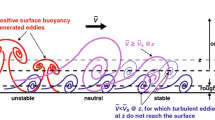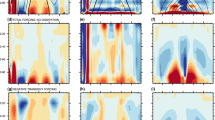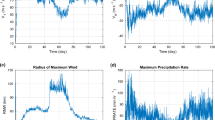Summary
The efficiency of successive satellite-observed stages in the development of extratropical frontal cyclones for transporting eddy sensible heat at 850 mb on the Southern Hemisphere, is determined for the five winters (June through September) of 1973–1977. An inventory of cloud vortex data is allied with independent estimates of the zonally-averaged transient eddy heat flux,\([\overline {v' T'} ]\), using a statistical technique known aspath analysis. Path analysis is an improvement over single equation linear regression models since it controls for the temporally continuous nature of cyclone evolution. The results indicate that different cloud vortex types are associated with characteristic regimes of\(\overline {v' T'} \). The quite strong poleward flux of heat effected in the cyclogenetic stages weakens substantially by the onset of dissipation. These results are in general agreement with those for the summer and transition seasons derived using linear regression by Tucker (1979). However, a significant netequatorward flux of\(\overline {v' T'} \) is found to be connected with the short-lived mature (spiral) cloud vortex type. In association with a southward displacement of the maximum latitude of cyclogenesis and a reduced crosslatitude motion of systems in winter, this apparently results in the strong lower-level heat flux convergence characteristic of the circumpolar trough at that time. A systematic error, by year, in the statistical model specification of heat transport related to cloud vortex type is found to be associated with phase of the Southern Oscillation (SO). Incorporating this effect into the model greatly improves the goodness-of-fit of the heat flux estimates and indicates that the efficiency of the mcridional eddy heat transport by cyclones is greatest (least) when the SOI is low (high). The implications of these results in the context of other, related studies are discussed.
Similar content being viewed by others
References
Asher, H. B., 1976: Causal modeling, Sage University Paper series on Quantitative Applications in the Social Sciences, 07-003. Beverly Hills and London: Sage Publications.
Carleton, A. M., 1979: A synoptic climatology of satelliteobserved extratropical cyclone activity for the southern hemisphere winter.Arch. Met. Geophys. Bioklim., Ser. B,27, 265–279.
Carleton, A. M., 1981: Monthly variability of satellite-derived cyclonic activity for the southern hemisphere winter.J. Climatol.,1, 21–38.
Carleton, A. M., 1987: Satellite-derived attributes of cloud vortex systems and their application to climate studies.Remote Sensing Envt.,22, 271–296.
Carleton, A. M. (in press): Eddy transport of sensible heat in winters marked by extremes of the North Atlantic Oscillation, 1948/49–1979/80.Mon. Wea. Rev.,115.
Hanushek, E. A., Jackson, J. E., 1977:Statistical Methods for Social Scientists. New York: Academic Press.
Howarth, D. A., 1983: Seasonal variations in the vertically integrated water vapor transport fields over the southern hemisphere.Mon. Wea. Rev.,111, 1259–1272.
Huang, H.-J., Vincent, D. G., 1985: Significance of the South Pacific convergence zone in energy conversions of the Southern Hemisphere during FGGE, 10–27 January 1979.Mon. Wea. Rev.,113, 1359–1371.
Kirk, A., 1987: Southern Hemisphere energy fluxes from analyses with special respect to the Weddell Sea region (Antarctica).Meteorol. Atmos. Phys.,37, 171–182.
Lejenäs, H., 1984: The annual cycle of the eddy momentum flux caused by the planetary-scale Southern Hemisphere 500 mb seasonally forced waves.J. Meteor. Soc. Japan,62, 252–260.
Lejenäs, H., 1987: A comparative study of Southern Hemisphere blocking during the global weather experiment.Quart. J. Roy. Meteor. Soc.,113, 181–188.
Meehl, G. A., 1987: The tropics and their role in the global climate system.Geograph. J.,153, 21–35.
Mo, K. C., van Loon, H., 1984: Some aspects of the interannual variation of mean monthly sea level pressure on the Southern Hemisphere.J. Geophys. Res.,89, 9541–9546.
Mo, K. C., White, G. H., 1985: Teleconnections in the Southern Hemisphere.Mon. Wea. Rev.,113, 22–37.
Mullan, A. B., Hill, H. W., Dini, P. W., 1986: The relationship of Southern Hemisphere planetary waves to typical weather regimes of the Southern Indian and Pacific oceans, In: Extended Abstracts, Second International Conference on Southern Hemisphere Meteorology, December 1–5, 1986: Wellington, N. Z. American Meteorological Society, Boston, Mass., pp. 180–183.
Newell, R. E., Kidson, J. W., Vincent, D. G., Boer, G. J., 1972, 1974:The General Circulation of the Tropical Atmosphere and Interactions with Extra-Tropical Latitudes, Volumes 1, 2. Cambridge, Ma., and London: MIT Press.
Pan, Y. H., Oort, A. H., 1983: Global climate variations connected with sea surface temperature anomalies in the eastern equatorial Pacific Ocean for the 1958–73 period.Mon. Wea. Rev.,111, 1244–1258.
Philander, S. G. H., 1983. El Niño Southern Oscillation phenomena.Nature,302, 295–301.
Physick, W. L., 1981: Winter-depression tracks and climatological jet streams in the Southern Hemisphere during the FGGE Year.Quart. J. Roy. Meteor. Soc.,107, 883–898.
Radok, U., Streten, N., Weller, G. E., 1975: Atmosphere and ice.Oceanus,18, 16–27.
Rosen, R. D., Eubanks, T. M., Dickey, J. O., Steppe, J. A., 1984: An El Niño signal in atmospheric angular momentum and earth rotation.Science,225, 411–414.
Salstein, D. A., Rosen, R. D., Baker, W. E., Kalnay, E., 1987: Impact of satellite-based data on FGGE general circulation statistics.Quart. J. Roy. Meteor. Soc.,113, 255–277.
Stefanick, M., 1982: Interannual atmospheric angular momentum variability 1963–73 and the Southern Oscillation.J. Geophys. Res.,87, 428–432.
Stokes, D. E., 1974: Compound paths: an expository note.Amer. J. Pol. Sci.,18, 191–214.
Streten, N. A., 1975: Satellite derived inferences to some characteristics of the South Pacific atmospheric circulation associated with the Niño event of 1972–73.Mon. Wea. Rev.,103, 989–995.
Streten, N. A., 1980: Some synoptic indices of the Southern Hemisphere mean sea level circulation 1972-77.Mon. Wea. Rev.,108, 18–36.
Streten, N. A., Troup, A. J., 1973: A synoptic climatology of satellite-observed cloud vortices over the Southern Hemisphere.Quart. J. Roy. Meteor. Soc.,99, 56–72.
Trenberth, K. E., 1976: Spatial and temporal variations of the Southern Oscillation.Quart. J. Roy. Meteor. Soc.,102, 639–653.
Trenberth, K. E., 1979: Interannual variability of the 500 mb zonal mean flow in the Southern Hemisphere.Mon. Wea. Rev.,107, 1515–1524.
Trenberth, K. E., 1981a: Observed southern hemisphere eddy statistics at 500 mb: frequency and spatial distribution.J. Atmos. Sci.,38, 2585–2605.
Trenberth, K. E., 1981b: Interannual variability of the Southern Hemisphere 500 mb flow: regional characteristics.Mon. Wea. Rev.,109, 127–136.
Trenberth, K. E., 1982: Seasonality in southern hemisphere eddy statistics at 500 mb.J. Atmos. Sci.,39, 2507–2520.
Trenberth, K. E., 1984: Interannual variability of the southern hemisphere circulation: representativeness of the year of the Global Weather Experiment.Mon. Wea. Rev.,112, 108–123.
Trenberth, K. E., 1987: The role of eddies in maintaining the westerlies in the Southern Hemisphere winter.J. Atmos. Sci.,44, 1498–1508.
Troup, A. J., Streten, N. A., 1972: Satellite-observed Southern Hemisphere cloud vortices in relation to conventional observations.J. Appl. Meteor.,11, 909–917.
Tucker, G. B., 1979: Transient synoptic systems as mechanisms for meridional transport: an observational study in the Southern Hemisphere.Quart. J. Roy. Meteor. Soc.,105, 657–672.
Tucker, G. B., 1981: Diagnostic studies of synoptic and planetary scale systems. International Conference on Preliminary Results of FGGE. Bergen, Norway: June 23–27, 1980. WMO/ICSU, 362–376.
Van Loon, H., 1979: The association between latitudinal temperature gradient and eddy transport. Part I: Transport of sensible heat in winter.Mon. Wea. Rev.,106, 525–534.
Van Loon, H., 1980: Transfer of sensible heat by transient eddies in the atmosphere on the Southern Hemisphere: an appraisal of the data before and during FGGE.Mon. Wea. Rev.,108, 1774–1781.
Van Loon, H., 1984: The Southern Oscillation. Part III: Association with the trades and with the trough in the westerlies of the South Pacific Ocean.Mon. Wea. Rev.,112, 947–954.
Van Loon, H., Shea, D. J., 1985: The Southern Oscillation. Part IV: The precursors south of 15o S to the extremes of the Oscillation.Mon. Wea. Rev.,113, 2063–2074.
Van Loon, H., Shea, D. J., 1987: The Southern Oscillation. Part VI: Anomalies of sea level pressure on the Southern Hemisphere and of Pacific sea surface temperatuce during the development of a warm event.Mon. Wea. Rev.,115, 370–379.
Wright, S., 1934: The method of path coefficients.Ann. Math. Stats.,5, 161–215.
Zapotocny, J. V., 1987: Relationships between available potential energy, kinetic energy and extratropical cyclone activity within East Coast cyclogenetic regions.J. Geophys. Res.,92, 8401–8410.
Zillman, J. W., Johnson, D. R., 1985: Thermally-forced mean mass circulations in the Southern Hemisphere.Tellus,37A, 56–76.
Author information
Authors and Affiliations
Additional information
With 7 Figures
Rights and permissions
About this article
Cite this article
Carleton, A.M., Whalley, D. Eddy transport of sensible heat and the life history of synoptic systems: A statistical analysis for the Southern Hemisphere winter. Meteorl. Atmos. Phys. 38, 140–152 (1988). https://doi.org/10.1007/BF01029778
Received:
Revised:
Issue Date:
DOI: https://doi.org/10.1007/BF01029778




